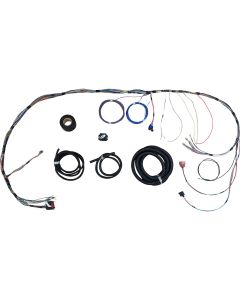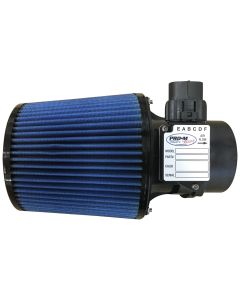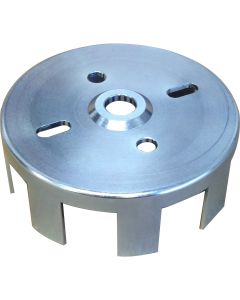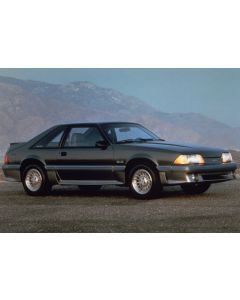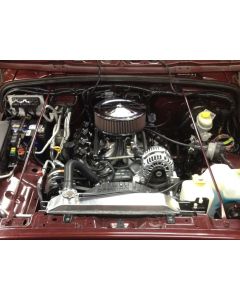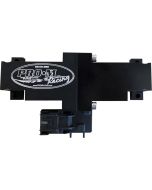350 Buick Complete Mass Air Sequential Port EFI System
The Pro-M EFI Complete conversion Kit for the Buick 350 is a Mass Air, sequentially fired, port fuel injection system, with full ignition control, and transmission controls, as well as a host of other features listed below. The Pro-M EFI system provides a combination drivability and quality typically only found in the OEM, combined with a level of performance typically only found in the aftermarket. It is truly the best of both worlds. All provided in a package so easy to use, most anyone can become their own tuner.
The Pro-M EFI Complete Conversion Kit for the Buick 350 Engine Comes Complete with The Following:
All new laptop tunable Pro-M EFI PCM. Shipped with a calibration file (Tune) to run your engine properly right out of the box! Tuning is neither required, nor is it recommended. The money you will save by not going to the tuning shop will pay for your Pro-M EFI system. No one else can make this claim. Our PCM is water and shock proof and suitable for under hood mounting if desired.
Pro-M EFI tuning software and USB communications gateway for easy laptop tuning via the OBD II connector! Our software package will allow you to make nearly any modification to your powertrain you could ever want and do so with amazing simplicity. The Pro-M EFI system can be as simplistic, or as sophisticated as the user wants it to be. Tune if you want to or leave it alone if you don't.
Pro-M EFI Supplied Intake Manifold.
Pro-M EFI custom 1000 CFM 4 bbl throttle body. It features all aluminum and stainless-steel construction, sealed ball bearings on the throttle shafts, and progressive linkage. Comes complete with idle control motor, throttle position sensor and 3 vacuum ports for your fuel pressure regulator, PCV valve, power brake booster, etc. This is absolutely the finest 4 bbl throttle body on the market!
Jumbo aluminum fuel rails and mounts. Rails have 9/16" diameter bores providing excellent flow and dampening characteristics.
Pro-M EFI custom compact high flow patented mass air meter. The Pro-M Racing On Throttle Body mass air meter is concealed within the air cleaner of your choice to maintain the vintage look! Not wanting the classic look? No problem. Just select one of the other Pro-M Racing mass air meters for draw through or blow through applications.
Complete assembled powertrain management harness. Many harness configurations available. The universal design of this harness allows you to enjoy all of the benefits of a high quality Mass Air powertrain management system, on virtually any engine, in any vehicle.
Eight high quality fuel injectors sized to your application. The injectors are sized to allow ample room for large increases in horsepower. These fuel injectors are held to much closer tolerance than typical production injectors.
All needed sensors (air charge temperature sensor, two O2 sensors and bungs, throttle position sensor, mass air sensor and coolant temperature sensor). Most of the sensors are mounted right on the injection system for a simple install.
High performance billet aluminum distributor complete with cap and rotor. The integral cam / crank position sensor allows for sequentially fired fuel injectors without the hassle of installing conventional cam and crank shaft position sensors. Our entire ignition system is contained within the distributor and ECM. Just install the distributor and plug it in to the harness. No spark boxes needed. This is NOT a cheaply made "fuel only" system like the competition sells. With Pro-M EFI the ignition timing is controlled by the Pro-M EFI PCM!
High performance coil featuring faster rise time and increased spark duration for increased performance. This coil comes with heat sink and mounting bracket.
Coil On Plug option available. Great for forced induction applications. Worlds better than a CD ignition box!
Throttle body base gasket, throttle cable bracket, assorted hardware and fittings and detailed instructions for a simple turnkey installation.
Easy to understand instruction manuals.
All these components are absolutely the best quality available. Unlike the competition, we will never sell you something that is "good enough" just because it costs less to produce.
| Featured | No |
|---|
Want to learn more? Below are overviews of the major features of the Pro-M EFI system.
Automatic Transmission Controls
The Pro-M EFI Powertrain Management system is a Mass Air, sequentially fired, port fuel injection system, with full ignition control, and transmission controls, as well as a host of other features listed below.
Water and shock proof OEM quality PCM. Made side by side with the OEM's. No one else does this!
OEM quality wiring harness.
Fully laptop programmable. Tune because you want to, not because you need to. Your laptop also acts as a powerful scan tool.
New improved calibration tool with multiple user levels. Tuning software so easy and intuitive, most anyone can be a tuner. Now compatible with both PC and Apple!
Store an unlimited number of tunes.
Tune on the fly and see the results immediately.
OBD II compatible. Not only does your laptop act as a powerful scan tool, you may also read codes and sensor data using a generic OBD II scan tool. The Pro-M EFI PCM uses the same code strategy and the same codes that all the OEM's use!
Automatic transmission controls for AODE/4R70W/4R70E/4R75W/4R75E
Manual shift option. Manually shift your automatic transmission!
Flex Fuel. Done the right way! Easily make big power on E85!
Traction control. Intergraded into the PCM! No parts to buy!
Advanced boost control for both turbo charged and supercharged applications, that actually works and is easy to use!
Launch assist.
Fully programmable progressive nitrous controls. No external controller needed!
Fully programmable progressive water/methanol injection controls. Done the right way. No external controller needed. Advanced OBD II diagnostics and fail-safe features make this absolutely the best water/methanol control system in the business.
Individual cylinder tuning.
Advanced timing control that actually rivals the accuracy and consistency of “Coil On Plug” high data rate ignition systems, while still using your distributor.
Optional “Coil On Plug” ignition system. Worlds better than a CD box! Read More . . .
Supports OEM “Coil Pack” and “Coil on Plug” ignition systems. If the engine you want to run was originally equipped with “Coil Pack” or “Coil On Plug” ignition, we can run those too!
Able to run two Mass Air Meters simultaneously. No limit to the amount of power you can make!
Easy, user adjustable two stage Rev Limiter. Cut fuel or spark or both.
T-56 Reverse lockout control.
Adaptive fuel control.
Adaptive idle controls.
Fuel pressure compensation.
Fuel pressure warning.
Electric cooling fan control with Soft Start feature.
Cooling fan cool down feature.
User programmable outputs.
“Decel Fuel” feature cuts fuel while decelerating. Saves fuel!
Operates in continuous closed loop with TWO wide band oxygen sensors (not one sensor like the other guys), which adjust each bank independently, resulting in the most precise control over air/fuel ratio in the industry.
No special tuning required for forced induction. Our “Load” based system makes forced induction super easy.
Advanced data logging feature built into the software.
Automatic updates for the calibration tool and user manuals.
Self-protecting PCM. The Pro-M EFI PCM detects short circuits and will shut down that PCM driver if a short is detected.
We cannot stress this enough...The real beauty of the Pro-M EFI system is that it can be as simplistic, or as sophisticated as you want it to be. It works perfectly right out of the box with some simple data entry, but if you want to tune, you'll have the most powerful tuning software ever offered anywhere by anyone, and OEM quality components that will last a lifetime.
If you want the best, look no further. There is simply no other management system that offers the quality, features, reliability, and ease of use that we offer with the Pro-M EFI engine management system, period...

The Pro-M EFI Powertrain Management system is an OEM quality, Mass Air, sequentially fired, port fuel injection system, with full ignition control and transmission controls. The Pro-M EFI system provides a combination of drivability and quality typically only found in the OEM, combined with a level of performance typically only found in the aftermarket. It is truly the best of both worlds.
It is easy to install, simple to use, and allows for customization of virtually every electronically controlled powertrain function. However, tuning is neither required, nor recommended. Tune if you want to, not because you have to. The money you will save by not going to the tuning shop will pay for your Pro-M EFI system. No one else can make this claim.
We accomplish this by adhering to the following principles:
- Use “Load” to calculate both the proper air/fuel ratio (Lambda) and the proper spark advance, as well as a host of other powertrain functions, under all conditions for both accuracy and flexibility.
- Use “Closed Loop” feedback for fuel, spark, idle control, water/meth injection, and anywhere else possible.
- Provide an excellent “base” calibration that will run any engine at an OEM level while still allowing for user modification to any parameter in an intuitive user interface
- Provide OEM level controls for popular features such as nitrous oxide, water/methanol injection, traction control, 2 step, launch assist, flex fuel, and more.
- Use only top quality components.
We will touch on each of these below.
1) Pro-M bases engine management on a value known as Load.
Though this may sound complex, engine management is not as complicated as you may think. Basic engine management boils down to two things: Lambda (Air/Fuel Ratio) and Spark Advance. The proper value for each of these can only be determined if we have an accurate value for Load.
It is important to understand that the proper a/f ratio, and the proper spark advance are dictated by nothing other than Load. Any other method is just guesswork.
Load is simply the air mass being ingested by the engine divided by the engine's potential for air mass. The engine's potential for air mass is calculated using the engine's displacement and the RPM. When using a mass air based engine management system, the ingested air mass is constantly obtained in real-time from the output of the mass airflow sensor. Therein lies the beauty of a mass air system – The single most important values for proper engine control is directly metered by a sensor and not derived from multiple other values. The Load calculations are done for you by the Pro-M EFI PCM. All you need to do is enter the proper information into the calibration: the MAF transfer function, the engine's bore and stroke, and the number of cylinders.
But doesn't the combination of engine parts dictate the needed a/f ratio and spark advance? Indirectly, yes it does. But that combination of engine parts is going to result in some amount of airflow, which will result in a certain value for Load, and that is what really matters. It does not matter how you get that airflow. All that matters is what you get. So indirectly, using this method, your a/f ratio and your spark advance are inherently customized to your combination of engine parts, simply by virtue of how it works.
It makes no difference what engine you are using. It makes no difference what heads and intake you have, what cam(s) you use, what you have for an exhaust system, or how many times you decide to change these things. It doesn’t even matter if you add forced induction or change the amount of boost on existing forced induction application. If the PCM knows your displacement, RPM, and your ingested air mass, it knows Load… and if it knows Load, then it can accurately control fueling and spark advance. It is that simple…
This is how all OEM systems work. The OEM systems that do not use mass air, generate their volumetric efficiency calculations by mapping out the engine with a mass air meter, then use that to determine Load. They can do this because they use the same engine combination over and over again but understand that every OEM management system uses Load.
The OEM method for using Speed Density is obviously not practical in the aftermarket since every engine will be different. Despite that, Pro-M EFI is the only aftermarket engine management system that uses Load.
2) Closed Loop Feedback ensures that what you want is what you get.
Closed Loop means the PCM is monitoring a particular engine variable and comparing it to the desired target. When there is a discrepancy, the PCM will automatically make corrections until the actual monitored value matches the target.
You may be familiar with the closed loop fuel controls used at idle and cruise in factory vehicles equipped with narrow band O2 sensors. For example, the target air/fuel ratio at idle is typically 14.7:1, but for a variety of reasons, the actual a/f ratio may not be at the targeted value. The narrow band O2s tell the PCM that the mixture is not correct. Operating in closed loop, the PCM makes a correction to the fueling until the O2s detect an actual ratio of 14.7:1, thus matching the target.
In recent years, OEMs have started to use closed loop feedback for fueling at all times (not just at idle and cruise) by replacing the narrow band O2s with wide band sensors that can accurately measure a much broader range of a/f ratios targeted under a variety of operating conditions. Pro-M EFI uses two wide band O2 sensors (One in each bank) to provide the most accurate fueling possible under any operating condition.
Additionally, the Pro-M EFI PCM uses an adaptive strategy to “learn” your engine's fueling needs. This results in the most accurate fueling calculations in the industry.
In addition to fueling, the Pro-M EFI system also utilizes closed loop feedback to precisely control idle speed. No more surging or varying idle speeds as various loads are put on the engine. The PCM constantly monitors actual idle speed, compares it to the target idle speed, then uses both the idle air control valve and spark advance until actual and target match under any condition. Furthermore, the PCM uses adaptive controls to “learn” how to control the idle speed and stores this information in its memory.
We even apply closed loop strategy to our water/methanol injection controls, which means you get exactly the amount of water/methanol injected into your engine that you asked for. OEM level control of an aftermarket add-on. It just doesn’t get better.
3) The Pro-M EFI system will run nearly any engine at an OEM level right out of the box. No tuning needed. But if you want to make changes, there is nothing simpler.
Again, herein lies the beauty of mass air. We always know exactly where we need to be in the base fuel and base spark tables because we are constantly monitoring actual ingested air mass and using this to calculate Load. Controlling both fuel and spark is as simple as delivering the commanded amount from the cells in the tables that correspond to the Load and RPM at that given instant. There are also modifiers for things like air charge temperature and coolant temperature that will adjust the target fuel and spark as required, but we have those all covered as well.
We ship every Pro-M system with all the fuel, spark, and modifier tables written for you. The values provided in those tables will give you the optimum blend of power, drivability, and fuel economy. A proper tune is a blend of all three of these things. We obviously aren’t going to give you values that will run your engine on the ragged edge to squeeze out every last drop of power. But if you'd like to modify those tables to make more, you certainly can. Add or subtract whatever you want from the base fuel and base spark tables. That’s all there is to it. The Pro-M EFI PCM will use the new values. Simple as that...
Many people who are shopping for engine management systems are doing so because they've spent a lot of money on performance parts hoping to make big power. Now they need something to pull it all together and make it run smoothly and reliably. Roll into a car show or even a gas station in a modified vehicle and what is the number one question you hear? It’s not “How smooth is your idle?” or “How does it run at part throttle?” It’s “How much power does it make?”
If you want the answer to that question, we know you’ll be taking your vehicle to a dyno. You can leave the calibration (or “tune”) alone and get your numbers. But, if you’re really in the game of making maximum power, we provide an easy way to modify the fueling and spark advance yourself to see if there is room for improvement. Or if you prefer, you can have a professional tuner do it for you. Tuners who have used our system agree – it’s as simple as simple can be to use.
Either way, you're not going to need to worry one bit about getting the engine to run right (provided it doesn’t have any mechanical issues). That includes cold starts, idling, cruising, deceleration… everything. No tuning needed. As for power, some quick changes for fuel and/or spark can be made in a matter of minutes to see what (if anything) can be gained. You’ll be in and out of the dyno in record time saving you time, money, and headache!
4) Pro-M’s system includes OEM style controls for all the popular “add-on” performance enhancing features.
As mentioned earlier, we can control water/methanol and nitrous oxide. We can control your automatic transmission. We offer helpful features like launch assist and traction control. We even offer an OEM quality Flex-Fuel system.
Why does that matter? Many of those items are available in separate packages in the aftermarket. Let’s use water/methanol (WM) as an example. You can buy a WM system that comes with its own controller. The problem is that the system controlling the engine and the separate controller for the WM system aren’t communicating with one another. With a separate controller, the engine management system has no idea that the extra fuel (methanol) is entering the engine. The result is the engine starts running rich from the extra fuel. There are tuning tricks to work around this, but that’s what they are... Tricks. Also consider the time and money you’ll spend trying to get it to run properly. The OEM doesn't use tricks to control your multi-thousand dollar engine. Neither do we. Because our system is controlling the WM system and commanding an exact flow amount, and because we monitor the actual flow being delivered, we know precisely how much fuel to deliver via the fuel injectors. This maintains the proper a/f ratio at all times. No tricks... We also know precisely how much to advance the spark based on our WM flow / Spark Adder table. On top of that, we use closed loop feedback to ensure that the amount of WM being injected is exactly what is being commanded. That’s OEM level control of an aftermarket product. The same fully-integrated control concept is applied to all the other features as well. No one else does this…
5) Pro-M uses and endorses only the very best components for its engine management systems.
Inferior quality parts can be your worst nightmare. It doesn't matter how fast the car is if you can't keep it out of the garage. For that reason, we use only the finest parts available.
The Pro-M EFI PCM is essentially a production Ford module. It is made on the same assembly line as the Ford ones are. It goes through all the same rigorous testing as the Ford modules. You'd be surprised what they put these through… Our modules share no code whatsoever with the production Ford modules, but our code is written by Ford contractors. You simply cannot do better than that. Why do we do this? We assure you, it's not because they are inexpensive. They are anything but. We do it because they are the best. Period...
The Mass Airflow Sensors… We truly believe our MAFs are second to none. We have been providing MAF sensors and generating MAF transfer functions virtually since the advent of the technology. No one knows it better. We perform all of our own flow testing and generate all our transfer functions in house right here in the USA. We have a variety of mass airflow meters employing many sizes, shapes and designs. We know what works best in a particular application. We are after all, primarily a mass air meter manufacturer.
Our wiring harnesses are constructed right here in the USA with the finest quality components available. Our exact fit powertrain harnesses are made to be exact duplicates of the originals, using all of the same connectors as the original harnesses for a fast and simple installation. These harnesses are assembled then covered in a protective loom, then wrapped in friction tape for good looks and to protect them from damage. Our universal fit harnesses are preassembled, but configurable for use in most any vehicle. These harnesses include protective loom and harness wrap so you can cover them up and protect them after you've configured them as needed. You will not find a better harness.
Some Frequently Asked Questions:
- Can I install your system myself?
- That’s really going to depend on your abilities. If you’re capable of removing your factory harness and remembering where everything goes when you plug in our new one, that’s a big plus. Outside of that, you’ll need some basic computer skills to download a program from our website and work with email attachments. Probably most importantly, you need to be capable of following directions and working methodically. If you’re not intimidated by any of that, then you should be totally qualified to get a Pro-M system installed and running in your car on your own. If you prefer to have the work done for you, then anyone meeting the requirements above can perform the work. It does not need to be a shop.
- That’s really going to depend on your abilities. If you’re capable of removing your factory harness and remembering where everything goes when you plug in our new one, that’s a big plus. Outside of that, you’ll need some basic computer skills to download a program from our website and work with email attachments. Probably most importantly, you need to be capable of following directions and working methodically. If you’re not intimidated by any of that, then you should be totally qualified to get a Pro-M system installed and running in your car on your own. If you prefer to have the work done for you, then anyone meeting the requirements above can perform the work. It does not need to be a shop.
- But isn’t a Mass Airflow Meter a restriction?
- This question originated back in the days when the Fox Body Mustangs came equipped from the factory with a very small Mass Air Meter that couldn't support much more than the stock engine. Is a mass airflow meter a restriction? It can be… Much like your intake manifold, or your throttle body, or your air cleaner can be a restriction if you choose the wrong one. For nearly 30 years now, Pro-M Racing has been selling Mass Air Meters that can support as much as 2000 horsepower. If that is not enough, then we can use two of them!
- This question originated back in the days when the Fox Body Mustangs came equipped from the factory with a very small Mass Air Meter that couldn't support much more than the stock engine. Is a mass airflow meter a restriction? It can be… Much like your intake manifold, or your throttle body, or your air cleaner can be a restriction if you choose the wrong one. For nearly 30 years now, Pro-M Racing has been selling Mass Air Meters that can support as much as 2000 horsepower. If that is not enough, then we can use two of them!
- My car has some mechanical problems. Is that going to be an issue?
- Most likely, yes. An engine management system isn’t a bandage for problems in the engine or fuel system. Don’t expect it to be. Proper drivability is dependent on the components in your car operating as they should. That said, the OEM level OBD II diagnostics of the Pro-M EFI system will help you to iron those out.
- Most likely, yes. An engine management system isn’t a bandage for problems in the engine or fuel system. Don’t expect it to be. Proper drivability is dependent on the components in your car operating as they should. That said, the OEM level OBD II diagnostics of the Pro-M EFI system will help you to iron those out.
- You make your system sound like the greatest thing out there. Is it too good to be true?
- We honestly believe that no other system currently available will be able to deliver the OEM level of drivability and quality that we offer. But… that doesn’t mean that we can’t do better. The truth is technology is advancing all the time. Pro-M constantly strives to take advantage of new technology and develop new components and software that will make what we think is already the best even better. We release updates and add new features on a constant basis, often at no extra charge to pre-existing customers. Do you have a feature in your car that we currently don’t control but would like us to incorporate? Let us know!
There are two strategies commonly used in engine management. One is Mass Air and the other is Speed Density.
Before we get into the differences, we should go over the very basics of engine management so that those who are not at all familiar with these things are up to speed.
For an engine to run, you must have four things.
1) Air – Air flow at any given time is a function of the combination of the engine parts and how much air is permitted to enter the engine via the throttle blade.
2) Fuel – The proper amount of fuel is added to that air via the fuel injectors.
3) Spark – Spark must occur to ignite the air/fuel mixture and it must happen at the proper time. The time at which this occurs is known as spark advance.
4) Compression – The air fuel mixture must be compressed in order to create the powerful explosion necessary to make power.
Only two of these things are engine management related. Those things are “Fuel” and “Spark”. The other two (Air and Compression) are strictly mechanical and are not controlled by the engine management system. The exception to that rule is electronic throttle control, but that topic is not relevant for the purposes of this article.
In a net shell, engine management is simply a matter of providing the proper amount of fuel and providing spark at the proper time. In order to make an intelligent and informed decision about which engine management system you should choose, it is important to understand the methods used to accomplish these things. Those methods are explained below:
1) Mass Air Engine Management
It's important to understand that the mass of the air being ingested by the engine is the single most important value necessary to determine how much fuel to supply to the engine and to determine what the spark advance should be. A Mass Air engine management system uses a Mass Air Meter to directly measure the mass of the air being ingested by the engine at any given time. You should also understand that the combination of engine parts is irrelevant when using Mass Air engine management. That combination will result in some amount of air mass. Since that air mass is directly measured, the combination of engine parts that resulted in that air mass simply does not matter. And for this reason, you can change that combination of engine parts as often as you'd like. You can even add a supercharger, or a turbocharger and this rule still applies.
The air mass value is used to calculate a value for “Load”. Load is defined as “Ingested Air Mass divided by Potential Air Mass”. It sounds complicated but it isn't. The ingested air mass is simply the reading taken by the mass air meter. The potential air mass is a calculation done by the PCM that uses the engine's cubic inch displacement and RPM.
When you have “Load”, you have everything you need to know. Load will determine what your air/fuel ratio should be. It will also determine what your spark advance should be. That's all there is to it.
2) Speed Density as it is used in OEM applications
Speed Density systems use a method where manifold vacuum and engine RPM are used to calculate the volume of air being ingested by the engine. That estimated volume of air is then corrected for temperature and pressure. There is much more to it than this, but for the purpose of this article, this explanation will suffice. There are several articles on the web that explain this in greater detail if you care to gain a deeper understanding of speed density.
I am often asked “Why do so many of the OEM auto manufacturers use Speed Density”. In the OEM, where cost is a major factor, there are obvious cost benefits to not having to install a Mass Air Meter in every vehicle. For that reason, and that reason alone, some OEM manufacturers will use speed density engine management. In an OEM application, speed density makes a lot of sense. Think about how much money they can save by not having to buy millions of mass air meters!
The method the OEM manufacturers use to do this is very time consuming and very expensive, but worth it since they can amortize this time over hundreds of thousands of vehicles that are all using the same engine.
That last sentence is very important. They will have an entire team of calibrators spend about six months mapping out a specific combination of engine parts in a controlled environment on an engine dyno. They will hold that engine at every possible combination of RPM, throttle position, temperature, and atmospheric pressure and use a mass air meter to record the air mass at each operating point. This data is used to calculate the Load values for the calibration (or “tune” as many people call it) that will be used for that engine. It is important to understand that the Speed Density systems used in the OEM still use load for their fueling and spark advance calculations.
They call this speed density, but a mass air meter was used to generate the data needed. This method works quite well, but you obviously cannot justify doing this in the aftermarket. In the aftermarket, every engine is different. You can't justify the time, even if you had access to the equipment necessary to do this. Not for one engine… For this reason, this version of speed density is not applicable to the aftermarket but is important to understand how this is done.
3) Speed Density as it is used in the aftermarket.
Let’s not get into speed density as it was used in the aftermarket in days past. Although this is still the basis of today’s aftermarket speed density systems, those archaic methods are rarely used anymore.
These days, speed density systems are almost always “Self-Learning” systems. While much better than the old methods, due to the significant savings in the amount of time spent tuning these, the simple truth is that it is just a faster method to get to the same old incorrect result.
The problem… You simply do not have the information you need to create a proper tune, because you have no method to measure air mass, and therefore no way to calculate “Load”.
The process... Tell the ECU what air/fuel ratio you want under the varying operating conditions. The “Self-Learning” systems will use feedback from a wide band oxygen sensor to achieve those values. Here is the problem… Where do you come up with those values? The answer? You guess until it runs.
Idle is simple. An air/fuel ratio of 14.7:1 will work. Experiment from there. Wide open throttle is a bit more involved but still simple. You experiment with values on the dyno until it makes max power. Not complicated but time consuming and expensive. The rest, which is everything in between, is just a bunch of guess work until you get it to run reasonably well. Understand that there are too many possible scenarios to ever get this anywhere near as good as it would be using a mass air engine management system. The simple truth is that everything in between idle and wide-open throttle is where you spend 99.9% of your time when driving your vehicle and it's also where you get the worst results.
Don't confuse “Self-Learning” with “Self-Tuning”, which is what many manufacturers call it. There is no such thing as self-tuning. The tuner still has to dictate to the ECU what the air/fuel ratios will be, and without a value for load, it’s all just guesswork.
How about spark advance? Speed Density offers you nothing to use to come up with proper spark advance values. Understand that spark advance is half the battle, and all you can do is guess.
You should also know that speed density systems work poorly with aggressive camshafts. Speed density systems rely heavily on the reading from the Manifold Absolute Pressure (MAP) sensor. Aggressive cams produce little vacuum and therefor little for the MAP sensor to work with.
Additionally, speed density systems need to be re-tuned every time you make a change to the engine. Even a small change. That’s great for the tuning shop. Not so great for you.
There are two reasons why an aftermarket EFI manufacturer wants to sell you a speed density system. Neither of them benefits the customer. First, they are less expensive to manufacture. Second, they put the burden of getting your engine to run properly on the end user.
A simple analogy.
If you want to know what the temperature is inside your house, which of these methods would you choose?
1) Read the thermometer inside your house.
2) Read the temperature outside and then figure for the output of your heating system, the R value of your walls and your roof, then apply all of this to some complex equation and with some reasonable amount of accuracy, calculate the temperature in your house.
As ridiculous as option 2 sounds, this is no different than using speed density. You would of course measure the temperature with a thermometer. For the same reason, you should be measuring your Air Mass with a Mass Air Meter.
But isn’t a Mass Air Meter a restriction?
It can be… Much like your intake manifold, or your throttle body, or your air cleaner can be a restriction if you choose the wrong one. For nearly 30 years now, Pro-M Racing has been selling Mass Air Meters that can support as much as 2000 horsepower. If that is not enough, then we can use two of them!
How about cost?
The Pro-M EFI system is comparable in cost to any decent system. No, we're not talking about the throttle body stuff. Those systems aren't even worth buying, but that's a whole other conversation. Compare the initial cost of our system to any of the decent ones out there and you'll see it is about the same. But the Pro-M EFI system is much easier to install, much easier to use, has worlds better technical support, and will save you thousands in money spent at the dyno. In the end, our system will cost you much less than what the others do and will give you much better results.
A final thought…
You are obviously buying an engine management system to make your engine run well, make power, and provide the best fuel economy possible. Given that those things are dictated entirely by air/fuel ratio and spark advance, shouldn't you buy an engine management system that will do those things properly?




